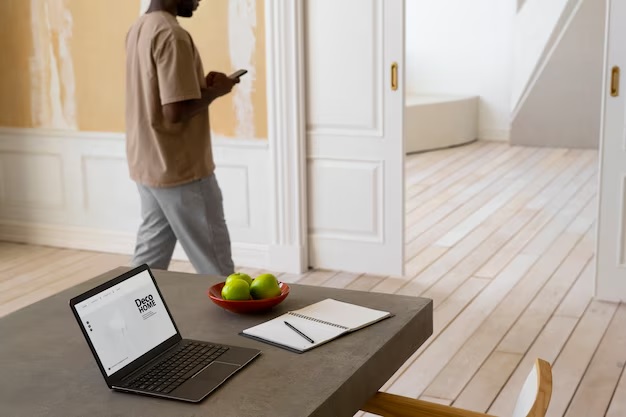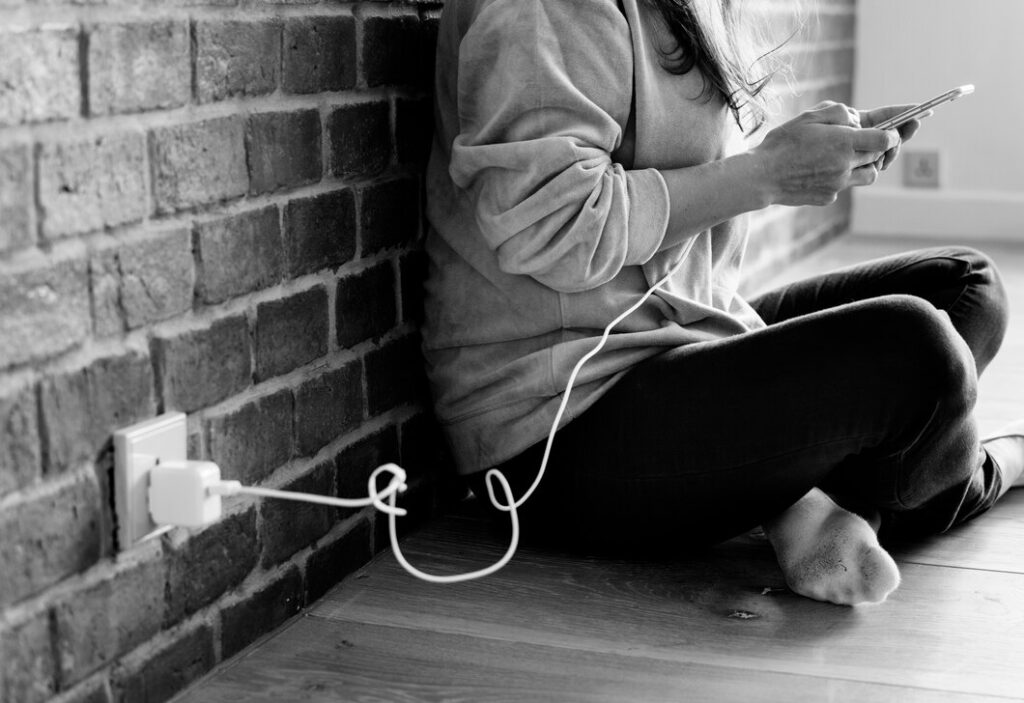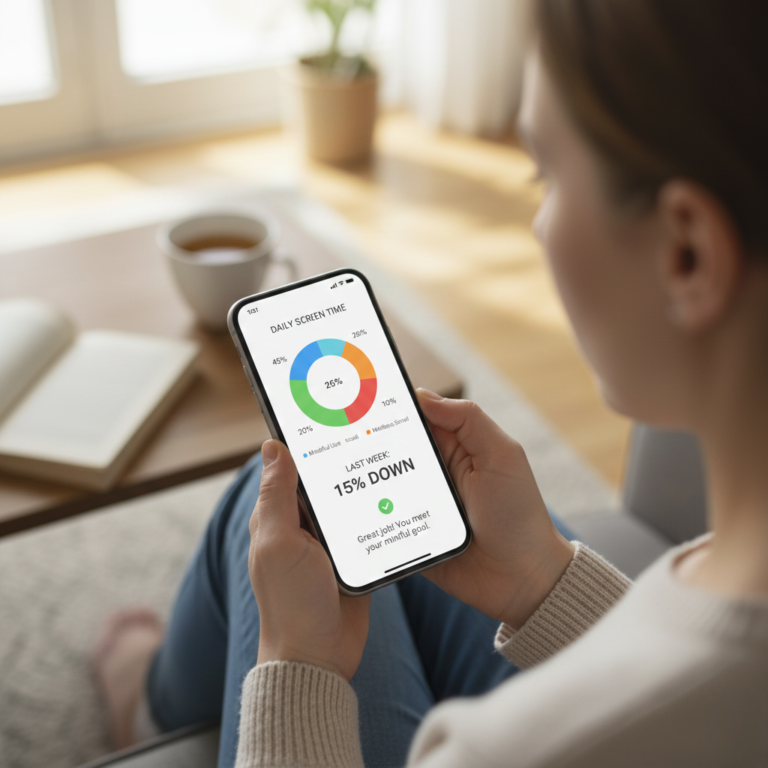
You reach for your phone before your eyes fully open. Your last screen glows in your face as you drift to sleep. The average notification gets your attention within 3 seconds. Sound familiar? In our busy lives, achieving digital balance can feel overwhelming. The solution isn’t a radical, one-time detox, but mastering the Art of Unplugging through a simple daily routine. It’s about making small, intentional choices that reclaim your focus and peace.
The statistics paint a sobering picture of our digital immersion: the typical American checks their phone 344 times daily—roughly once every 4 minutes of waking life.
Meanwhile, studies from the American Psychological Association show that 65% of adults now believe periodic “digital detoxes” are essential for mental health, yet only 28% successfully implement such breaks. Perhaps most concerning, research from Harvard Business School reveals that constant digital connectivity is associated with a 26% increase in stress hormones and significantly diminished creativity and deep thinking.
As a digital wellness consultant who’s helped hundreds of professionals reclaim balance, I’ve witnessed remarkable transformations when people establish intentional unplugging practices. One executive I worked with increased her deep work capacity by 40% after implementing morning and evening tech-free rituals. Another client—a chronically overwhelmed entrepreneur—reported that his anxiety levels dropped dramatically once he established clear digital boundaries within his daily schedule.

In this comprehensive guide, you’ll discover:
- The neurological impact of constant connectivity on your brain and wellbeing
- Why random acts of unplugging often fail to create lasting change
- A practical framework to develop personalized daily digital balance routines
- 50 proven unplugging practices that enhance presence, creativity, and connection
- How to maintain digital boundaries even in a hyper-connected workplace
By the end of this journey, you won’t just understand why unplugging matters—you’ll have a sustainable daily routine that helps you use technology intentionally rather than being used by it. Let’s reclaim your attention, one mindful moment at a time.
Understanding Our Digital Dependency
Creating a balanced relationship with technology requires understanding the powerful forces that created imbalance in the first place.
Our digital lives didn’t become all-consuming overnight. They expanded gradually through the perfect convergence of advancing technology, sophisticated engagement tactics, and fundamental human vulnerabilities. The typical smartphone now delivers a psychological reward system more powerful than anything humans have previously encountered outside of addictive substances.
Research from the MIT Technology Review shows that the average person touches their phone 2,617 times daily. Each interaction triggers a small dopamine release, creating what neuroscientists call a “compulsion loop”—a cycle of anticipation, action, and reward that keeps us returning to our devices even when we consciously wish to disconnect. These loops are especially powerful because they deliver variable rewards—we never know when the next notification might deliver something genuinely important or pleasurable.
Our digital tools are also uniquely designed to exploit specific cognitive vulnerabilities:
| Human Vulnerability | Digital Exploitation |
| Fear of missing important information | Notification systems and social FOMO |
| Need for social validation | Likes, comments, and digital recognition |
| Completion bias (desire to finish tasks) | Unread counts and progress indicators |
| Tendency toward mindless habits | Frictionless access and infinite content |
| Response to psychological triggers | Personalized content algorithms |
Why is balance so elusive now? Unlike previous technological transitions, the digital revolution places powerful computers in our pockets, removes natural usage boundaries, and employs sophisticated behavioral design to maximize engagement. We’re navigating an environment specifically engineered to capture and hold our attention, often at the expense of our well-being.
By understanding these dynamics, we can see that digital balance isn’t a matter of willpower—it’s about redesigning our environments and routines to work with our psychology rather than against it.
10 Warning Signs Your Digital Life Needs Rebalancing
Recognizing the symptoms of digital imbalance is the first step toward establishing healthier patterns. While technology use is normal and necessary, these signs indicate your relationship with devices may need recalibration:
- You experience anxiety when separated from your devices – Genuine discomfort or stress when your phone or laptop is inaccessible
- First screen/last screen has become your daily pattern – Your device is the first thing you check upon waking and the last thing you see before sleeping
- You struggle to complete focused work without interruption – Finding yourself checking notifications or switching tasks every few minutes
- Real-world interactions feel less engaging than online content – In-person conversations seem dull compared to the stimulation of digital media
- You’ve noticed declining attention span for longer content – Difficulty staying engaged with books, articles, or extended conversations
- Your posture has adapted to device use – Developing “text neck,” wrist pain, or other physical symptoms of excessive screen time
- You use devices to escape uncomfortable emotions – Automatically reaching for your phone when feeling bored, anxious, or lonely
- People comment on your digital habits – Friends or family expressing concern about your screen time or digital responsiveness
- You feel phantom vibrations or notification sounds – Imagining your phone is alerting you even when it isn’t
- You’ve tried to cut back but return to old patterns – Previous attempts to establish digital boundaries haven’t created lasting change
How many of these signs resonate with your experience? If you identified with three or more, establishing a daily unplugging routine could significantly enhance your wellbeing and effectiveness.
Preparing for Successful Digital Balance
Creating lasting digital balance requires thoughtful preparation, not just good intentions. Setting the right foundation dramatically increases your chances of developing sustainable unplugging habits.
Clarifying Your Digital Wellness Values
Begin by articulating exactly what balance means to you. Research from the Journal of Personality and Social Psychology shows that connecting new habits to personal values increases follow-through by 74%.
Reflect on these questions:
- How would technology ideally serve your life (rather than dominate it)?
- What specific activities or experiences do you want to protect from digital intrusion?
- Which aspects of technology provide genuine value versus mindless consumption?
- What does “enough” technology use look like for you?
Document your reflections to create what psychologist Kelly McGonigal calls “value-based intention”—a clear articulation of why digital balance matters in your particular life context.
Understanding Your Digital Triggers
Sustainable unplugging requires recognizing the specific cues that initiate problematic technology use. Common triggers include:
- Emotional states – Boredom, anxiety, loneliness often prompt reflexive device use
- Environmental cues – Physical locations or visual reminders of devices
- Social dynamics – Others’ device use triggering your own
- Time-based patterns – Certain times of day associated with technology use
- Internal justifications – “Just checking quickly” thoughts that lead to extended use
Keep a brief “digital trigger diary” for 3-5 days, noting circumstances surrounding unintended or excessive technology use. This awareness creates what behavior scientist BJ Fogg calls the “spine of behavior change”—the conscious recognition needed before new routines can take root.
Designing Your Environment for Success
Your physical environment shapes your behavior more powerfully than willpower alone. Research from Harvard Business School demonstrates that environmental design is 2-3 times more effective than self-control for changing habitual behaviors.
Implement these environmental modifications:
- Create device-free zones in your home, particularly bedrooms and dining areas
- Establish charging stations away from high-use areas to prevent mindless access
- Use physical barriers like time-lock containers for scheduled unplugging periods
- Make alternative activities visible and accessible in areas where you typically use devices
- Set up visual reminders of your unplugging goals in locations where you’ll see them regularly
- Recruit accountability from friends, family, or colleagues
“The most reliable way to change behavior is not through motivation but through environment,” notes James Clear, author of ‘Atomic Habits.’ “Make unplugging easier than remaining plugged in by thoughtfully arranging your surroundings.”
By preparing thoroughly, you’re creating the conditions for sustainable change rather than short-lived digital detox attempts that quickly revert to old patterns.
The 30-Day Digital Balance Blueprint
Meaningful habit formation happens through progressive practice, not overnight transformation. This 30-day blueprint guides you through establishing daily unplugging routines that become increasingly natural over time.
Week 1: Foundation Digital Boundaries (Days 1-7)
Objective: Establish basic unplugging practices and observe their immediate impact
Actions:
- Create tech-free morning and evening routines (minimum 30 minutes each)
- Implement “notification batching” – checking updates at scheduled times
- Designate one meal daily as completely device-free
- Experiment with grayscale mode on your phone to reduce visual stimulation
- Practice a 30-second mindful pause before unlocking devices
- Begin tracking your usage patterns with a screen time app
- Each evening, reflect on how unplugged periods affected your day
What to expect: The first week often brings awareness of just how reflexive device use has become. Initial discomfort is normal and typically peaks around day 3-4. Many people report feeling simultaneously anxious and relieved during their first structured unplugging periods.
Week 2: Deepening the Practice (Days 8-14)
Objective: Expand unplugging beyond basic boundaries and address specific digital habits
Actions:
- Extend tech-free morning routine to include intention-setting for the day
- Implement a two-hour “deep work” block with devices in do-not-disturb mode
- Try a full device-free evening (from dinner until bedtime)
- Delete one non-essential app that consistently draws your attention
- Replace digital activities with analog alternatives for specific use cases
- Practice the “pocket check” technique before entering social situations
- Begin using physical cues (like a special bracelet) to remind yourself of digital intentions
What to expect: As initial resistance fades, many people report increased awareness of how technology affects their mood, focus, and relationships. Physical sensations of craving digital stimulation may arise but typically become manageable with practice.
Week 3: Integration and Identity Shift (Days 15-21)
Objective: Move from conscious effort to natural integration of unplugging practices
Actions:
- Implement a device-free day or half-day on weekends
- Create social unplugging experiences by inviting others to participate
- Design personalized “speed bumps” for your highest-use digital activities
- Explore alternatives to your most habitual digital patterns
- Practice “tech Sabbaths” – designated periods of complete digital abstention
- Begin transitioning from digital to analog tools in one area (notes, reading, etc.)
- Reflect on emerging identity as someone who values digital balance
What to expect: Week three often brings a noticeable identity shift from “trying to use less technology” to “being someone who values presence.” Many report improved sleep, attention span, and interpersonal connection by this stage.
Week 4: Personalization and Long-term Integration (Days 22-30)
Objective: Create a sustainable personalized approach to digital balance for the long term
Actions:
- Design your ideal daily technology template with scheduled unplugging periods
- Create context-specific protocols for different environments (work, home, travel)
- Establish “non-negotiable” unplugging practices to maintain even during busy periods
- Develop maintenance and recovery strategies for high-digital-demand times
- Articulate personal digital boundaries to communicate to others
- Create environmental reminders of your commitment to balance
- Draft your “digital philosophy” statement capturing your approach to technology
What to expect: By day 30, most people have identified which unplugging practices provide the greatest personal benefit and have begun to establish them as normal parts of daily life rather than special exceptions.
50 Practical Unplugging Practices for Your Daily Routine
Digital balance doesn’t require complete technological abstinence—it’s about intentional practices that create space for presence and connection. These techniques are organized to address different aspects of digital balance:
Morning Rituals (Start with Intention)
- Create a “sacred hour” before devices each morning
- Use a physical alarm clock instead of your phone
- Replace morning social media with journaling or meditation
- Prepare breakfast mindfully without digital distraction
- Take a short morning walk without devices
- Read physical material (book, newspaper) before digital content
- Practice “three deep breaths” before first device check
- Set daily intention for technology use
- Create a physical “to-be” list before checking your digital “to-do” list
- Drink a full glass of water before engaging with screens
Workday Boundaries (Focused Productivity)
- Schedule specific times for email and message checking
- Use the Pomodoro technique with complete device disconnection
- Implement “airplane hours” for deep work sessions
- Create physical workspace zones designating device usage
- Use “shutdown rituals” between work tasks
- Take device-free breaks between digital work sessions
- Practice eye-relief exercises hourly (20-20-20 rule)
- Use physical note-taking for important information
- Turn off all non-essential notifications during work hours
- Implement “tech Shabbats”—designated periods of complete digital abstention
Relationship Cultivation (Connected Presence)
- Establish device-free meals with family or friends
- Create a “phone stack” ritual during social gatherings
- Practice “first attention”—greeting others before devices
- Designate certain activities as always device-free (walks, intimate conversations)
- Use “airplane mode dates” for uninterrupted connection
- Create physical conversation cards for dinner discussions
- Practice active listening without device checking
- Develop a “pocket check” habit before entering social spaces
- Make eye contact during conversations instead of partial attention
- Schedule regular unplugged social experiences
Evening Wind-Down (Restorative Disconnection)
- Establish a “digital sunset” time when screens go off
- Create a dedicated charging station outside the bedroom
- Replace evening scrolling with reading physical books
- Practice a gratitude ritual without digital tools
- Use candlelight or dimmed lighting during unplugged evening hours
- Take an evening bath or shower as a transition ritual
- Write tomorrow’s priorities on paper before bed
- Listen to music or podcasts without looking at screens
- Practice progressive relaxation without devices nearby
- Establish a “last thoughts” journal replacing final screen check
Mindful Tech Usage (Conscious Connection)
- Create a “waiting rule”—alternate between device use and present awareness when waiting
- Implement “tech-positive” experiences—intentional technology use that enhances life
- Practice the “one screen rule”—using only one digital device at a time
- Establish device-free zones in your home
- Use physical timers for digital activities
- Create analog alternatives for common digital activities
- Practice “tech fasting”—periodic complete disconnection
- Implement mindfulness triggers when reaching for devices
- Use physical movement as a transition between digital activities
- Create a personal “digital nutrition” framework distinguishing healthy versus unhealthy technology use
The most effective approach is selecting practices that address your specific digital challenges while aligning with your values and lifestyle.
“The goal isn’t digital minimalism but digital intentionality,” explains Dr. Alex Soojung-Kim Pang, author of ‘Rest: Why You Get More Done When You Work Less.’ “The practices that stick are those that create more value than they require.”
Integrating Unplugging Into Your Ongoing Life
The aim isn’t temporary digital detoxing but permanent lifestyle integration. After your 30-day rebalancing journey, here’s how to maintain digital wellness as part of your normal routine:
The Minimum Viable Unplugging Practice
Even during your busiest periods, certain foundational elements preserve digital balance. Research from the Digital Wellness Institute suggests these core practices:
- Device-free sleep zone – No phones in the bedroom (or at minimum, not beside the bed)
- Tech-free transitions – The first and last hour of each day remain unplugged
- Attention unitasking – One screen at a time, fully engaged rather than partially distracted
- Scheduled disconnection – At least 2-3 hours daily without digital interruption
- Weekly digital reset – A longer period (minimum 4 hours) of complete unplugging weekly
“These five practices serve as a protective foundation,” explains Dr. Doreen Dodgen-Magee, psychologist and digital wellness expert. “When maintained consistently, they preserve your neurological capacity for deep thinking, presence, and authentic connection.”
Creating Context-Specific Protocols
Different life domains require tailored approaches to unplugging. Develop specific protocols for:
- Workday unplugging – Structured breaks, focused work methods, communication boundaries
- Home environment balance – Device-free zones, family technology agreements, evening rituals
- Social interaction frameworks – Presence practices, device etiquette, attention prioritization
- Travel and transition protocols – How to maintain balance during disrupted routines
- High-demand period strategies – Modified approaches during unusually busy seasons
“The most sustainable digital balance comes from having different gears rather than a single approach,” notes Linda Stone, former Apple and Microsoft executive. “Design protocols that can flex with your life while preserving your core values.”
Modeling Digital Balance for Others
Your relationship with technology influences those around you more powerfully than any advice you could offer. Whether at home, work, or in your community, your unplugging practices create permission and possibility for others.
For Parents and Families
Children internalize digital habits primarily through observation rather than instruction. Research from Common Sense Media reveals that 62% of teens report wishing their parents would spend less time on devices, while parents underestimate their screen use by an average of 35%.
Effective family approaches include:
- Creating family media agreements with input from all members
- Establishing clear tech-free zones and times in the home
- Modeling healthy technological boundaries consistently
- Having open conversations about both benefits and challenges of technology
- Developing family rituals that center presence rather than devices
For Workplace Leaders
Organizational digital culture starts with leadership behavior. Studies from Harvard Business School show that leader technology habits are mirrored throughout organizations, with teams unconsciously adopting the digital boundaries (or lack thereof) modeled by managers.
Impactful workplace practices include:
- Setting clear expectations about after-hours communication
- Creating meeting protocols that prioritize presence
- Respecting others’ focus time by batching non-urgent communications
- Discussing digital wellness as part of team performance conversations
- Demonstrating work-life boundaries through your own unplugging practices
“The most powerful digital wellness program is a leader who models balanced technology use,” explains workplace researcher Arianna Huffington. “No policy can compete with the lived example of healthy digital boundaries.”
Troubleshooting Common Digital Balance Challenges
Even with thoughtful preparation, obstacles will emerge when establishing new digital habits. Here’s how to navigate the most common challenges:
“I have legitimate work demands that require constant connectivity.”
Solution: Distinguish between actual requirements and assumed expectations. Many “urgency” cultures develop without explicit discussion. Experiment with scheduled availability—communicating clearly when you will be fully responsive and when you’ll be focusing deeply with minimal interruption. Create appropriate emergency channels for truly urgent matters while batching routine communications. Consider discussing “responsible responsiveness” with leadership to develop team norms that support both connectivity and focus.
“I experience strong FOMO (fear of missing out) when unplugged.”
Solution: FOMO typically diminishes with regular unplugging practice as you discover that truly important information reaches you through multiple channels. Implement a “capture and review” system to document concerns or curiosities that arise during unplugged periods, then address them during connected time. This reassures your brain that nothing important will be permanently missed. Additionally, consciously reframe FOMO as JOMO (joy of missing out)—noting the positive experiences gained during unplugged time that would otherwise be lost.
“My social circle communicates primarily through digital channels.”
Solution: Begin by setting clear expectations about your response patterns rather than disappearing without explanation. Create scheduled check-in times for digital social platforms rather than remaining continuously available. For close relationships, suggest alternative connection methods for important communications during your unplugged periods. Remember that quality engagement during connected periods often contributes more to relationships than constant low-quality availability.
“I’ve tried unplugging before but always return to old habits.”
Solution: Failed previous attempts often result from relying on willpower rather than systems. Focus on designing your environment and establishing triggers that make unplugging the path of least resistance. Start with smaller, more achievable unplugging periods that gradually expand as they become comfortable. Use the “habit stacking” technique by connecting new digital boundaries to existing reliable routines. Most importantly, practice self-compassion when setbacks occur—habit formation is rarely linear, and sustainable change comes through persistence despite imperfect implementation.
When to Seek Additional Support
If you find that despite multiple attempts:
- You experience significant anxiety or distress when attempting to unplug
- Digital habits are substantially interfering with relationships or responsibilities
- You notice signs of genuine technology addiction rather than simply imbalanced use
These may indicate underlying issues that would benefit from professional support. Digital wellness coaches, therapists specialized in technology habits, or structured programs can provide additional strategies and accountability.
Reclaiming Your Attention, Reclaiming Your Life
The time and attention you give to screens isn’t just time spent—it’s life exchanged. In the average lifespan, we now spend nearly 34 years looking at screens. Each moment spent in mindless scrolling represents a conscious choice about how you invest your finite attention—the currency of your existence.
This 30-day journey toward digital balance isn’t about rejecting technology’s value. It’s about reclaiming intentionality in a world designed to capture and monetize your attention. As philosopher William James noted over a century ago, “My experience is what I agree to attend to.” In an age of unprecedented competition for that attention, the ability to unplug routinely and intentionally has become nothing less than an act of personal freedom.
The practices you’ve explored aren’t merely about using screens less—they’re about living more. Each unplugged moment creates space for the depth, creativity, and connection that digital immersion often squeezes out of our lives. The small daily choices to look up rather than down, to engage rather than escape, collectively create the architecture of a life characterized by presence rather than distraction.
Ready to begin? Choose just one unplugging practice from this guide, implement it today, and notice not just what you’re turning away from, but what you’re turning toward.
To support your journey, download our free [Digital Balance Blueprint] with tracking tools, reflection prompts, and expanded practices to help you develop your personalized approach to unplugging.
Frequently Asked Questions
Won’t unplugging make me less productive or cause me to miss important information?
Research consistently shows the opposite effect. Studies from Stanford University demonstrate that periodic unplugging actually increases productivity by enhancing focus, creativity, and cognitive stamina. The “always on” approach creates an illusion of productivity while actually fragmenting attention and depleting mental resources.
As for missing information, truly important communications typically reach us through multiple channels or persist until we reconnect. The psychological weight of potential missed information often far exceeds the actual impact. Most professionals discover that after establishing clear expectations about their availability, the world adapts surprisingly well to their unplugging patterns.
What about necessary digital tools and legitimate technology needs?
Digital balance doesn’t mean technological rejection—it means technological intentionality. The goal is distinguishing between conscious, value-aligned technology use and mindless consumption habits. When unplugging, focus first on eliminating low-value digital activities while preserving those that genuinely enhance your life and work.
For necessary digital tools, implement boundaries that concentrate usage into specific time periods rather than allowing them to infiltrate your entire day. The most balanced individuals aren’t those who use technology least, but those who use it most purposefully—maintaining clear distinctions between connection and disconnection rather than living in a perpetual state of partial attention.
How do I handle others’ expectations about my digital availability?
Communication is essential. Rather than simply disappearing, clearly articulate your new boundaries and response patterns to key people in your life. Frame these changes positively—explaining how being more present and focused will benefit your relationships and effectiveness. Provide alternative contact methods for truly urgent matters during unplugged periods.
Remember that your boundaries will initially feel more uncomfortable to you than to others, who are often less aware of your response patterns than you imagine. Most importantly, recognize that by modeling balanced digital habits, you create permission for others to establish similar boundaries, potentially initiating positive cultural shifts in your work and personal communities.
What if my job requires constant digital connectivity?
Even in the most connected professions, spaces for unplugging exist if intentionally created. Start by distinguishing between actual job requirements and workplace norms that have evolved without deliberate design. Experiment with “batched responsiveness”—designating specific periods for communications while protecting others for focused work.
Discuss reasonable expectations with supervisors, framing digital balance as a performance enhancement strategy rather than a personal preference. Consider implementing “technology bridges” during unplugged periods—delegated coverage, emergency-only contact methods, or scheduled check-ins that preserve focus while ensuring responsiveness for truly time-sensitive matters. Remember that sustainable performance in any role requires the cognitive renewal that comes from periodic unplugging.
How do I handle digital unplugging when family members have different technology preferences?
Family digital harmony requires understanding that different relationships with technology can coexist within the same household. Begin with open, non-judgmental conversations about each person’s digital needs, concerns, and preferences. Focus on creating agreed-upon technology-free zones and times that everyone commits to honor, while allowing flexibility in other areas.
Consider implementing a “technology by design” approach—making conscious family decisions about when, where, and how devices will be used rather than defaulting to constant availability. For parents of younger children, remember that consistency matters more than perfection; even modest unplugging practices, when maintained reliably, create powerful modeling that shapes children’s long-term relationship with technology.



